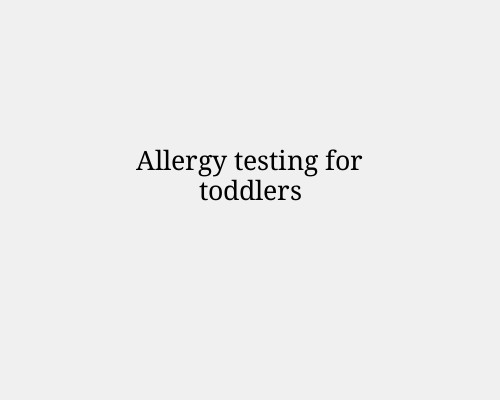
Allergy testing for toddlers: food sensitivity and what parents should know
Food allergies and sensitivities in toddlers can be stressful for both the child and their parents. At this stage of life, children are still developing their immune systems, and their reactions to certain foods can vary widely—from mild skin rashes to severe, life-threatening responses.
Understanding the types of tests available, their accuracy, and what steps to take is crucial for proper diagnosis and management.
Food allergy vs. food sensitivity
Before diving into testing, it’s important to understand the distinction:
Food allergy: An immune system reaction that occurs shortly after eating a particular food. Even small amounts can trigger symptoms such as hives, swelling, vomiting, breathing difficulty, or anaphylaxis. Common culprits include milk, eggs, peanuts, tree nuts, wheat, soy, fish, and shellfish.
Food sensitivity/intolerance: Unlike allergies, sensitivities do not involve the immune system in the same way. They may cause delayed or mild reactions such as stomach upset, bloating, eczema flare-ups, or irritability. For example, lactose intolerance is a sensitivity, not an allergy.
Signs of food allergies in toddlers
Symptoms of a food allergy often appear quickly (within minutes to 2 hours). Watch for:
Hives or skin rash
Swelling of lips, eyes, or face
Vomiting or diarrhoea
Coughing, wheezing, or difficulty breathing
Extreme fussiness or inconsolable crying after eating
Food sensitivities, however, may take longer to show up and include:
Gas, bloating, or stomach pain
Loose stools or constipation
Eczema flare-ups
Sleep disturbances
Behavioural changes after eating
Types of allergy testing for toddlers
Skin prick test (SPT)
A small amount of allergen extract is placed on the skin (usually the forearm or back) and lightly pricked.
If the toddler is allergic, a raised bump (similar to a mosquito bite) will appear.
Pros: Fast results (within 15–20 minutes), widely used, inexpensive.
Cons: Can be uncomfortable, may produce false positives, requires specialist supervision.
Blood test (IgE Test / RAST or ImmunoCAP)
Measures the level of allergy-related antibodies (IgE) in the blood against specific foods.
Pros: No skin pricking, safer for children with severe eczema or asthma, results not affected by antihistamines.
Cons: Requires a blood draw, may be less precise, results can take several days.
Oral food challenge (OFC)
The toddler is fed the suspected allergen in gradually increasing amounts under close medical supervision.
Considered the gold standard for diagnosing food allergies.
Pros: Most accurate way to confirm or rule out an allergy.
Cons: Risk of severe reactions, only performed in a clinical setting.
At-home sensitivity tests (not recommended)
Hair, saliva, or finger-prick blood tests marketed online for food sensitivities are not scientifically validated.
These often measure IgG antibodies, which only indicate food exposure, not an allergic reaction.
Paediatricians and allergists do not recommend these for diagnosing food issues.
When to consider testing
Testing should be discussed with your paediatrician if your toddler shows:
Repeated or severe reactions after eating certain foods
Persistent eczema that does not improve with treatment
Chronic digestive issues linked to meals
Family history of severe allergies
Do not remove multiple foods from your toddler’s diet without medical advice. Restrictive diets at this age can lead to nutrient deficiencies.
Preparing for a toddler’s allergy test
Medical history: Your child’s doctor will ask about reaction timing, food triggers, and family history.
Medications: Antihistamines may need to be stopped before a skin prick test. Always ask your doctor.
Comfort: For blood draws or skin tests, bring a favourite toy or blanket to ease anxiety.
Managing food allergies or sensitivities
If an allergy is confirmed:
Avoid the trigger food completely.
Learn to read ingredient labels carefully.
Ask your paediatrician if you should carry an epinephrine auto-injector (EpiPen).
Work with a registered dietitian to ensure your toddler gets balanced nutrition.
If it’s a sensitivity rather than an allergy:
Tolerance levels may vary; some children can handle small amounts.
Keep a food diary to track symptoms.
Discuss with your paediatrician whether foods should be reduced, avoided, or reintroduced later.
Key takeaways
True food allergies in toddlers are immune-based and can be serious, while food sensitivities cause discomfort but are not life-threatening.
Reliable testing includes skin prick tests, blood tests, and oral food challenges under medical supervision.
At-home sensitivity kits are not reliable and should not guide dietary changes.
Always involve a paediatrician or paediatric allergist before testing or eliminating foods.
Would you like me to expand this article with a list of the most common toddler food allergies and their typical symptoms to make it more beginner-friendly and SEO-optimized for your website?